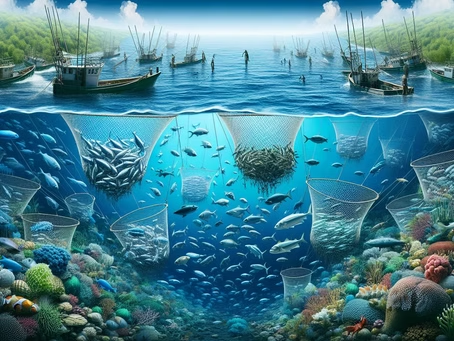The Urgency of Combating Overfishing
Overfishing is one of the most pressing challenges facing the world’s oceans. It depletes fish stocks, destabilizes marine ecosystems, and threatens biodiversity. Beyond the environment, it undermines the livelihoods of fishing communities and jeopardizes global food security. Addressing this crisis requires coordinated policies, technological innovation, and consumer responsibility. This article explores the drivers of overfishing, its consequences, and the solutions that can help restore balance to our seas.
Why Overfishing Spells Trouble
The Domino Effect on Ecosystems
- Predators lose access to prey, disrupting natural balances.
- Scavengers face shortages, altering survival strategies.
- Herbivores overgraze on algae, degrading coral and seafloors.
The removal of too many fish affects every layer of marine life, from plankton to whales. Overfishing pulls at the threads holding the ocean’s complex food web together.
Biodiversity Under Threat
- Disrupted food chains weaken resilience across species.
- Bycatch pushes rare species closer to extinction.
- Loss of genetic diversity reduces adaptation to change.
Safeguarding biodiversity is not just about saving individual species but preserving the ocean’s entire ecological foundation.
Impact on Habitats
Coral reefs and seagrass meadows, vital nurseries for marine life, suffer as overfishing disrupts the balance of grazers and predators. The result is declining water quality, collapsing food webs, and the loss of critical habitats that sustain future fish populations.
The Global Overfishing Crisis
Hotspots Around the World
The Western Pacific, Southeast Asia, and the Mediterranean are among the regions hardest hit, though overfishing spans every ocean. These hotspots illustrate the global nature of the problem, interwoven with environmental, social, and economic pressures.
Illegal, Unreported, and Unregulated Fishing
- Operating without authorization or in restricted zones
- Ignoring quotas or falsifying catch data
- Targeting protected or endangered species
IUU fishing undermines legal operations and accelerates fish stock depletion. Combating it requires international cooperation, stronger enforcement, and greater transparency.
Consumer Demand
Global appetites drive exploitation. From sushi-grade bluefin tuna to omega-3 supplements, consumer demand strains fish populations. Year-round availability of seasonal species and marketing of exotic catches add pressure. Each purchasing decision has the power to either reinforce or reduce unsustainable practices.
Fish on the Brink
The Bluefin Tuna
Industrial fleets and soaring demand have pushed bluefin tuna toward collapse. Overfishing often targets juveniles before reproduction, threatening species survival and marine balance.
Cod’s Collapse
Once thought inexhaustible, Atlantic cod collapsed in the 1990s, devastating ecosystems and coastal communities. Its story is a stark warning of the consequences of unchecked exploitation.
Sharks in Peril
Slow-growing sharks are especially vulnerable. Driven by demand for fins, many species face extinction. Their decline disrupts food chains and weakens reef and seagrass ecosystems.
The Human Cost
Livelihoods at Risk
Fishing communities face declining incomes, job losses, and fading traditions as fish stocks dwindle. The ripple effects extend to entire local economies.
Economic Strain
- Seafood scarcity drives up prices.
- Tourism suffers when marine life declines.
- Coastal economies lose stability.
Food Security
With billions depending on fish as their primary protein, overfishing poses a grave risk. Nutritional gaps from dwindling seafood could worsen malnutrition, particularly in vulnerable populations.
Solutions and Innovations
Sustainable Policies
Success stories such as Alaska’s salmon fishery and North Sea haddock recovery prove that strict quotas and science-based management can restore fish populations when enforced effectively.
Technology at Sea
- Satellites and AI track illegal fishing.
- Eco-friendly gear reduces bycatch and habitat damage.
- Aquaculture offers alternatives, though it requires careful management.
The Power of Consumers
Shoppers and diners can drive change by choosing seafood certified by sustainability labels, asking about sourcing, and supporting businesses that value ocean-friendly practices.
The Future of Fish
Rebuilding Stocks
Recovery takes decades and depends on consistent enforcement, habitat protection, and global cooperation. Some species rebound quickly, but slow-growing fish like sharks may require generations.
Conservation Strategies
- Artificial reefs to restore habitats
- Citizen science for monitoring and advocacy
- Marine Protected Areas offering safe havens
Conclusion
Overfishing is not just an environmental problem but a social and economic one. Yet hope remains. With stronger policies, innovative technology, and informed consumer choices, we can restore fish stocks, protect biodiversity, and secure food supplies for generations. The oceans’ future depends on the action we take today.
Frequently Asked Questions
What is overfishing?
Overfishing happens when fish are caught faster than they can reproduce, threatening ecosystems and food supplies.
Which species are most at risk?
Bluefin tuna, cod, and sharks are highly vulnerable, alongside many species caught as bycatch.
How does overfishing impact people?
It reduces livelihoods, harms economies, and jeopardizes food security for billions reliant on seafood.
What solutions exist?
Science-based quotas, eco-friendly fishing gear, aquaculture, and Marine Protected Areas are effective solutions.
What role do consumers play?
Consumers can help by buying sustainable seafood, asking about sourcing, and supporting protective policies.

